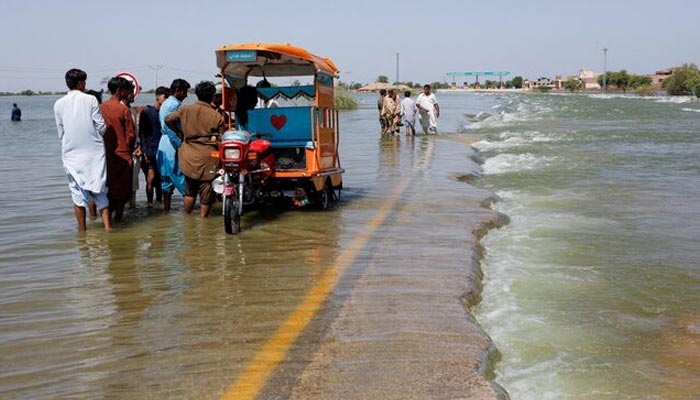Climate exodus
Climate migrations are already taking place across the globe in high-risk regions
September 03, 2024

This year has been a year of elections, the most ever observed in a calendar year in international history. It has also been a year of increasing far-right populism.
A common theme across all elections has been increasing rightwing populism, fanning the flames of anti-immigrant rhetoric and policies. Over time, this has cultivated hostile anti-immigrant and anti-asylum sentiments. Ahead of the EU vote, far-right parties gained significant traction, where anti-immigrant platforms were leading the polls in countries such as France and Germany.
A key driver of this shift is populist rhetoric framing immigrants as threats to national identity and security. This further exacerbates public fears amid growing economic instability. A recent manifestation of this was the Islamophobia-driven pogroms ablaze in the UK proving the result of such divisive political rhetoric.
As climate disasters become one of the leading drivers of migration, what will this mean for the future of global migration and refugee crises? Slow-onset events such as droughts, rising temperatures and sea levels, and sudden disasters, like glacial lake outburst floods and the adjacent costs of the loss and damage, will be contributors to the largest exodus of displaced people in the coming years.
Such stressors hit agrarian societies like Pakistan hardest, exacerbating food insecurity and destroying community livelihoods, forcing migrations to urban centers and eventually abroad.
Climate migrations are already taking place across the globe in high-risk regions. The poorest in the world are being forced to escape their homes because of the Global North hegemony that is predominantly responsible for the climate crisis in the first place.
However, developing legal and safe immigration pathways for climate migrants is not a palatable political concept. Instead, populism necessitates the clamping down of already militarised borders, the pursuit of strengthened anti-immigrant laws, and painting those seeking a better life as a threat to their economy, livelihoods, and society at large.
Seven of the world’s biggest GHG emitters collectively spent $33 billion on border and immigration enforcement during 2013-2018, which is twice the amount they spent on climate finance for disasters in the Global South.
The Intergovernmental Panel on Climate Change was the first to establish the link between climate and migration but met with much resistance from countries fearing it would encourage illegal immigration. It took a decade of dialogue for climate-driven migration to finally be part of the United Nations Framework Convention on Climate Change. Before the loss and damage and adaptation agreements, the plight of migrants was invisible on the agenda. It was not until COP21 that the Task Force on Displacement was established. Although it’s a start, there is a long and perilous road ahead.
A major bottleneck is also the lack of clarity on a legally binding definition of what constitutes a climate migrant. They are not covered by the existing 1951 Refugee Convention and the 1967 addendum relating to the status of refugees, which grants them eligible and legal grounds for protection. The far-right has already drawn borders on what constitutes deserving refugees and migrants, leaving further ambiguity about climate migrants. Our colonial histories, multinational fossil fuel corporations, anti-immigrant rhetoric, and militant border securities are tools of the Global North to build a wall against future migrants and refugees.
There is much historical precedent to suggest the West would be hesitant against forced migrations. Examples include the brutal treatment of asylum seekers trapped in Australia’s Christmas Island detention centre or the hostility faced by Syrian and Palestinian refugees fleeing war to Greece on lifeboats in inhumane conditions. The lives lost became just another drop in the ocean. These are not examples in silos, but a continuum revealing a larger anti-immigrant pattern.
Mass migration is not new to the Subcontinent given our histories with partition, but future migration patterns will be informed by changing climate. In South Asia, this will largely be internal displacement. According to the Global Report on Internal Displacement, as of 2022 South Asia recorded a total of 12.6 million internal displacements by disaster, 90% of which were triggered by floods. Pakistan had one of the highest numbers of internal displacements caused by disaster, with a record 8.2 million movements predominantly caused by the 2022 floods.
Addressing climate displacement demands mobilising climate finance to fund local adaptation relative to mitigation, ensuring frontline communities are protected and not forced into migration. The government must leverage climate financing, strengthen locally led adaptation efforts, invest in climate-resilient infrastructure, improve disaster warning systems, and meet mitigation targets to offset future calamities.
Given the ambiguity around the status of climate migrants, a holistic and legally binding definition is crucial. Instead of hardening borders and fueling anti-immigrant narratives, the West has a moral obligation to assist victims of climate injustices. Some countries are now considering climate visas to facilitate migration and residency for those displaced by climate change. The effects of climate change are a transboundary and national security issue requiring regional cooperation, information sharing, and policies that support safe and legal immigration pathways for those most vulnerable to disasters.
The writer is a development and policy graduate with an interest in climate change and its various intersections. She can be reached at: [email protected]
Disclaimer: The viewpoints expressed in this piece are the writer's own and don't necessarily reflect Geo.tv's editorial policy.
Originally published in The News









